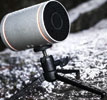IR laser diode used in 3D camera
25 July 2012
Opto-Electronics

A fast laser diode from OSRAM Opto Semiconductors has been used to provide light for a new 3D camera from Swedish manufacturer Fotonic. The component was developed especially for 3D cameras and facilitates range finding for moving objects with good depth resolution at video rate.
The infrared laser diode provides high optical power of about 0,5 W, even when in continuous wave operation. With a wavelength of about 845 nm the light is hardly visible to the human eye, and yet it is well within the sensibility range of the camera chip.
Three-dimensional cameras superimpose a two-dimensional picture with information on the range and surface profile of an object. Industrial applications for such systems are, for example, the gauging of fluid levels or the grading of objects according to size or shape. Three-dimensional sensors also provide reliable stereoscopic information, e.g. for the control of robot arms.
The Fotonic C70 camera is based on a CMOS sensor and makes use of the principle of time-of-flight measurement. A laser diode, which is integrated into the camera, transmits a light pulse which the target reflects back. Each of the 120x160 pixels of the camera chip records the distance to the object by measuring a respective phase shift compared to the emitted light pulse.
The precision of this distance measurement and the range of the sensor increases with the modulating frequency of the light source. Due to their fast switching times of only a few nanoseconds, laser diodes are particularly well suited for this application.
Within the range of 0,1 to 7 metres, the camera measures distances with an accuracy of 3 up 30 millimetres.
For more information contact Ryan Hunt, OSRAM Opto Semiconductors, +27 (0)79 525 1779, [email protected], www.osram.co.za
Further reading:
Africa’s future internet could be on overland submarine cables
Opto-Electronics
SEACOM aims to explore an innovative new concept: utilising submarine cable technology to address the longstanding challenges in Africa’s terrestrial infrastructure.
Read more...
Versatile range of camera modules
EBV Electrolink
Opto-Electronics
The CAM-66GY pro-modules from ST are a full range of sample camera modules made for a seamless evaluation and integration of the VD66GY 1,5-megapixel colour image sensor.
Read more...
Enhanced breaker status and communication module
Schneider Electric South Africa
Opto-Electronics
Schneider Electric has announced the launch of its new Breaker Status and Communication Module (BSCM) Modbus SL/ULP, which delivers enhanced performance, improved connectivity, and simplified integration for power distribution systems.
Read more...
Heat-resistant LEDs
Opto-Electronics
Würth Elektronik’s new RGB LEDs are characterised by excellent heat resistance with an insensitivity to temperatures from -40 to 100°C making them ideal solutions for reliable, colour-variable lighting in applications at high operating temperatures.
Read more...
PhotoMOS relays
Future Electronics
Opto-Electronics
The AQY221R2SX and AQY221R2S PhotoMOS from Panasonic Industry ensures excellent characteristics and high-speed switching performance.
Read more...
Mouser now shipping onsemi’s image sensors
TRX Electronics
Opto-Electronics
The AR0145CS is a 1/4,3-inch CMOS digital image sensor with a 1280 (H) x 800 (V) active-pixel array that can capture both continuous video and single frames.
Read more...
Adaptive optics’ power solution
Altron Arrow
Opto-Electronics
Vicor power-dense adaptive optical modules enable colossal telescopes to look into the past for deep space discoveries.
Read more...
Ultra-high speed photo detection
Opto-Electronics
TDK Corporation has announced a photo-spintronic conversion element combining optical, electronic, and magnetic elements that can respond at an ultra-high speed of 20 picoseconds.
Read more...
High-speed lasers
RFiber Solutions
Opto-Electronics
Macom are a high-volume manufacturer of lasers, deploying more than 100 million devices with a reliability of less than 50 FIT and greater than 100 years of wear-out lifetime
Read more...
High-performance optical interconnect
Opto-Electronics
STMicroelectronics has unveiled its next generation of proprietary technologies for higher-performing optical interconnect in datacentres and AI clusters.
Read more...


